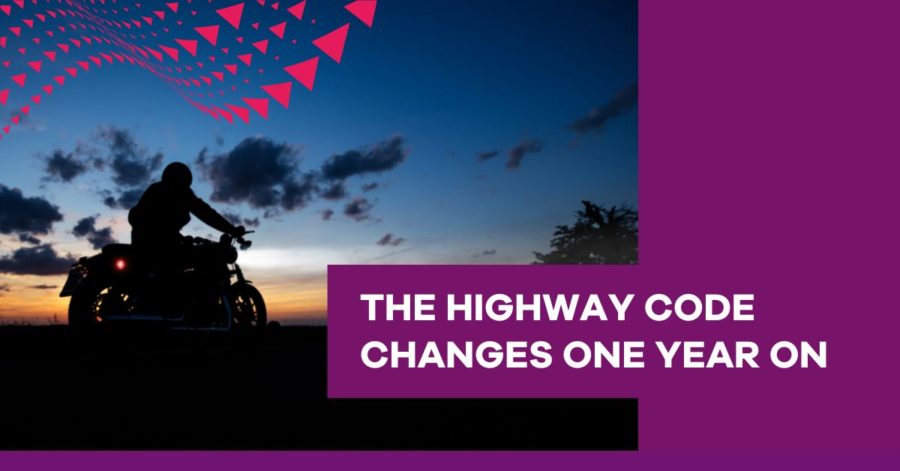
It is now 12 months since the last big update to the Highway Code in January 2022, which laid out changes to make our roads safer and protect the most vulnerable road users – cyclists, pedestrians, horse riders.
It is still too early for any official accident statistics but if recent surveys are anything to go by, it seems that many drivers are still unaware of the changes and what they mean for road safety.
The 2022 Highway Code changes – what were they?
From a driver’s perspective some of the biggest changes to the Highway Code in January 2022 were:
- The creation of a new ‘hierarchy of road users’ that ensures those who can do the greatest harm have the greatest responsibility to reduce the danger or threat they may pose to others
- Clarification of the existing rules on pedestrian priority on pavements and when crossing the road
- Guidance on safe passing distances and ensuring cyclists and horse riders have priority when travelling straight ahead at junctions
The changes give more clarity on priority in certain circumstances and in theory should mean our roads are a safer place, but only if everyone is aware of them and follows them.
Lack of awareness of changes to Highway Code
According to several surveys carried out during 2022, awareness of the changes was and still is poor. In a survey by road safety charity IAM Roadsmart in April 2022, 20% of the 1000 respondents were not aware of the changes. Over half (51 per cent) of respondents admitted they can’t remember the last time they referred to the Highway Code.
Regarding establishing a hierarchy of road users, where those in charge of the vehicles that can cause the greatest harm should bear the greatest responsibility – the majority (56%) agreed that this is the right way forward, but 26% said they were against and almost one in five (19%) were still to be convinced either way.
In September 2022, AA Accident Assist revealed that 60% of drivers still hadn’t read the updated Highway Code rules. Just 39% had read the new rules and one in 10 drivers between the ages of 18 to 54 were completely unaware of the changes to the Code, compared to one in 20 drivers over 55.
A survey by the RAC who surveyed 2000 UK drivers found that 67% of the respondents felt that there had not been enough publicity about the changes and 47% of drivers had not actively checked the updates to the Highway Code.
Just a few days ago (January 2023) the findings of a YouGov poll, carried out on behalf of Cycling UK, were released. They show little improvement in awareness levels one year on from the changes.
The poll found that a quarter (25%) of the adults questioned were not aware of the changes to the Highway Code. Of those who were aware of the changes, just 28% were able to correctly answer the question “how much space should a driver leave when overtaking people cycling at speeds of up to 30mph”.
Sarah Mitchell, Cycling UK’s chief executive said at the end of January:
“A year on since the Highway Code update, the lack of understanding and knowledge of the changes is alarming. If widely adopted, these changes can save lives and make the roads better for everyone – but if you’ve not passed your [driving] test in the last year, it’s unclear how you would know about them.”
Long-term awareness campaign needed to change driving behaviours
If the various survey results are anything to go by the THINK education campaign named ‘Travel Like You Know Them’ run by the Department of Transport following the updates in January 2022, has not had the intended impact.
The consensus amongst driving bodies and organisations seems to be that more needs to be done to improve awareness so that driving behaviours change.
Ben Bradshaw, MP for Exeter and patron of the All-Party Parliamentary Cycling and Walking Group said:
“It is not realistic for government to expect decades of entrenched driving behaviour to change overnight. It took years for attitudes and habits to change over seatbelts, but they did in part thanks to a long-term public awareness campaign. We need a similar campaign to communicate the changes to the Highway Code if we’re to make our roads safer and get more people cycling and walking.”
Matthew Midgley, solicitor and team leader of Minster Law’s Bike team, said:
“Having sat and looked at that the cases over the last year since the change in the Highway Code, it is fair to say that whilst this is a benefit to the biker community, nothing much seems to have changed. We have been using the hierarchy when arguing liability to defendants, but this seems to be glossed over by the other side. Which is either indicative of a lack of understanding or just an acceptance that the hierarchy was almost already in place.
We haven’t noticed it produce any results in trial outcomes, but again, this could be that bikers were more vulnerable before the Highway Code change, so this has more been more of a reinforcement of the message that was already in place.
One thing to note from my drives around the country, car drivers don’t seem to be giving any more space to bikers and cyclists than they did before the change, so perhaps the wider population need a greater understanding of the changes than they already do.”
It is too early to see whether the changes have made our roads safer, but if the awareness statistics are anything to go by, we may not be seeing casualty numbers on our roads reducing as much as hoped for this year.



